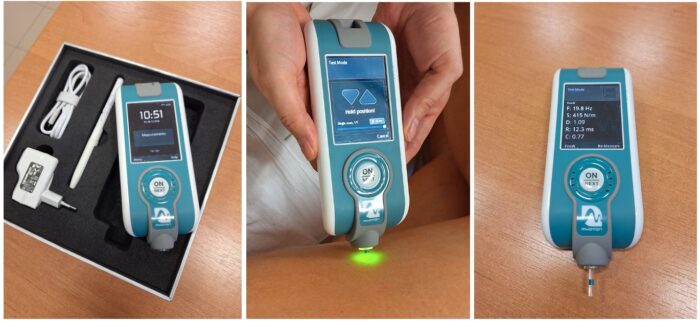Publications

Monitoring Hip Joint Muscle Function in Osteoarthritis Patients Following Arthroplasty: A Prospective Cohort Study
Authors: Dorota Staniak 1, Alicja Wojcik-Zaluska 1, Krzysztof Sokolowski 2, Malgorzata Drelich 3, Izabela Swietlicka 4, Monika Prendecka-Wrobel 5, Teresa Malecka-Massalska 5
Affiliations:
- Department of Clinical Physiotherapy, Medical University of Lublin, 20-059 Lublin, Poland
- Department of Physiotherapy, Faculty of Health Sciences, Vincent Pol University, 20-816 Lublin, Poland
- Department of Rehabilitation, Medical University of Lublin, 20-059 Lublin, Poland
- Department of Biophysics, University of Life Science, 20-950 Lublin, Poland
- Physiology Department, Medical University of Lublin, 20-059 Lublin, Poland
Journal: Journal of Clinical Medicine - February 2025, Volume 14, Issue 3, Article no. 976 (DOI: 10.3390/jcm14030976)
-
Field & Applications:
- Medical
- Treatment evaluation
- Orthopedics
- Gerontology / Ageing
- Musculoskeletal disorder
- Musculoskeletal rehabilitation
- Muscle symmetry
- Muscle development / Performance
Background/Objectives: Osteoarthritis (OA) is a chronic and progressive joint disease, leading to functional limitations and significantly impairing the quality of life. Muscle weakness, reduced mobility, and compensatory biomechanical changes are common consequences, further exacerbating functional decline. The aim of this study was to assess the impact of hip osteoarthritis on muscle functionality and to evaluate the effectiveness of hip arthroplasty using the MyotonPRO device to measure key biomechanical parameters, i.e., tension, stiffness, and flexibility.
Methods: This cohort study included 40 patients (17 women and 23 men; mean age 64.55 ± 10.49 years) with advanced hip OA (Kellgren-Lawrence grade III-IV) undergoing hip arthroplasty. Measurements of muscle tension (F), stiffness (S), and flexibility (D) in the gluteus maximus, rectus femoris, and biceps femoris were performed at three time points: before surgery, on postoperative days 8-10, and one month after hospital discharge. Pain (VAS), balance (Tinetti scale), and functional ability (WOMAC index) were also assessed.
Results: Hip arthroplasty significantly reduced pain levels (VAS: 6.38 ± 0.28 preoperatively to 1.88 ± 0.22 postoperatively, p < 0.001) and improved functional ability (WOMAC: p < 0.001). Muscle tension and stiffness of the gluteus maximus initially increased after surgery (tension: 11.57 ± 0.32 to 12.15 ± 0.38, p = 0.009), reflecting compensatory stabilization but decreased by the final evaluation. Flexibility improved significantly over time (p = 0.014). The biceps femoris muscle exhibited a significant reduction in tension one month postoperatively (p = 0.015), alongside decreased stiffness (p = 0.015) and enhanced flexibility. The rectus femoris muscle showed minor changes in biomechanical properties, with no statistically significant differences detected.
Conclusions: Osteoarthritis significantly impacts muscle function, reducing the gluteus muscle tension and stiffness, which compromises joint stability and triggers compensatory activity in the rectus femoris and biceps femoris muscles. Postoperative rehabilitation is essential for improving flexibility and addressing compensatory muscle tension.

Figure 1. MyotonPRO device. Measurement involves examining the mechanical properties of muscles using short impulse and mechanical force, generating damped muscle vibrations. The built-in accelerometer records the oscillatory response of the muscle and translates it into records like tension (F), stiffness (S), and flexibility (D). The photo was taken in the Department of Orthopedics and Traumatology of the University Clinical Hospital No. 4 in Lublin.
Keywords: hip osteoarthritis, arthroplasty, MyotonPRO, muscle function
Observed reduction in tension and stiffness of the gluteus muscles prior to surgery suggests that osteoarthritis affects joint stability and forces compensatory activity from the rectus femoris and biceps femoris muscles.
The asymmetry in the rectus femoris and biceps femoris muscles between the affected and unaffected sides, both before surgery and immediately after the procedure, may indicate that these muscles play a role in the compensatory activity of the lower limbs.
Rehabilitation after hip arthroplasty is crucial for restoring muscle function, particularly in improving flexibility and reducing compensatory muscle tension.
The gluteus maximus plays a central role in stabilizing the joint after surgery, while changes in the rectus femoris are less pronounced.
The biceps femoris muscle demonstrates positive postoperative adaptation, highlighting the effectiveness of surgical and rehabilitation interventions in restoring its function.


